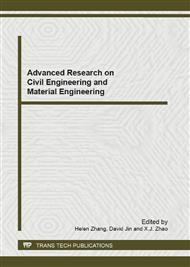[1]
Hou Laiguang, Zeng Lingke. Ceramic waste comprehensive utilization status[J]. China ceramic industry, 2005, 12(4): 41-44. (in Chinese).
Google Scholar
[2]
Zeng Lingke. Method of using ceramic waste to prepare sandwish ceramisite agitator[P]. China: 200610037494. 6, 2007. 02. 21.
Google Scholar
[3]
Li Yufeng. The development and utilization of ceramic wastes [J]. Fo Shan Ceramic, 2003, 03: 16-18. (in Chinese).
Google Scholar
[4]
Feng Bing. Preparation method of ceramic polishing waste mud ceramisite agitator[P]. China: 01107686. 0, 2002. 11. 06.
Google Scholar
[5]
Bi Shu. Process method of using ceramic polishing residues or ceramic waste to produce ultra-thin ceramic polishing brick technique [P]. China: 200510020420. 7, 2005. 10. 19. (in Chinese).
Google Scholar
[6]
Mu Songlan, Ma Guanghua, Li Qingtao et al. Study on using buliding ceramic polishing waste to preprae lightweight ceramic materials [J]. Journal of ceramics,2005, 6: 71~79. (in Chinese).
Google Scholar
[7]
Bi Shu. Method of using ceramic polishing waste to prepare plastic and rubber stuffing [P]. China: 200410081577. 6, 2005. 09. 21.
Google Scholar
[8]
Ma Zhixin. Application of using ceramic polishing waste to prepare filter materials [P]. China(: 200410102509. 3, 2005. 07. 13.
Google Scholar
[9]
M. Codina, C. Caudit Coumes, P. Le Bescop etal. Design and characterization of low-heat and low-alkalinity cements[J]. Cement and Concrete Research, 2008, 38: 437~448.
DOI: 10.1016/j.cemconres.2007.12.002
Google Scholar
[10]
Sung-Yoon Hong, FP Glasser. Alakli sorption by C-S-H and C-A-S-H gels partII: Role of alumina, Cement and Concrete Research, 2002, Vol. 32: 1101-1111.
DOI: 10.1016/s0008-8846(02)00753-6
Google Scholar


